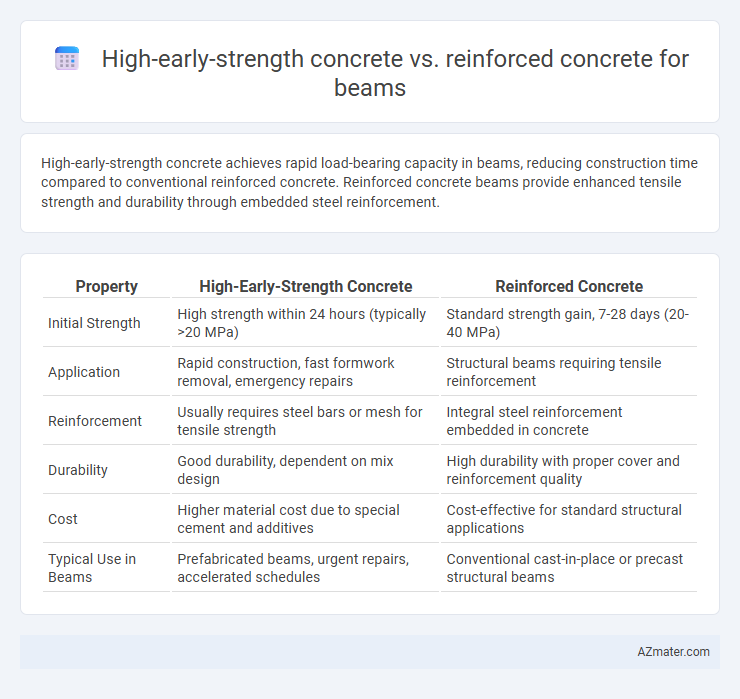High-early-strength concrete achieves rapid load-bearing capacity in beams, reducing construction time compared to conventional reinforced concrete. Reinforced concrete beams provide enhanced tensile strength and durability through embedded steel reinforcement.
Table of Comparison
| Property | High-Early-Strength Concrete | Reinforced Concrete |
|---|---|---|
| Initial Strength | High strength within 24 hours (typically >20 MPa) | Standard strength gain, 7-28 days (20-40 MPa) |
| Application | Rapid construction, fast formwork removal, emergency repairs | Structural beams requiring tensile reinforcement |
| Reinforcement | Usually requires steel bars or mesh for tensile strength | Integral steel reinforcement embedded in concrete |
| Durability | Good durability, dependent on mix design | High durability with proper cover and reinforcement quality |
| Cost | Higher material cost due to special cement and additives | Cost-effective for standard structural applications |
| Typical Use in Beams | Prefabricated beams, urgent repairs, accelerated schedules | Conventional cast-in-place or precast structural beams |
Introduction: Understanding Concrete Types for Beams
High-early-strength concrete accelerates curing, enabling faster load-bearing capacity in beams and reducing construction time. Reinforced concrete incorporates steel bars to enhance tensile strength, ensuring durability and structural integrity under heavy loads. Selecting the appropriate concrete type depends on project requirements for strength, speed, and long-term performance.
What is High-Early-Strength Concrete?
High-early-strength concrete is a type of concrete designed to achieve high compressive strength at an accelerated rate, typically reaching 70% of its specified strength within 24 hours. This rapid strength gain makes it ideal for applications requiring quick formwork removal or early load application in beams, reducing construction time significantly. In contrast, reinforced concrete integrates steel reinforcement bars to provide tensile strength, but the concrete itself cures at a standard rate, making high-early-strength concrete a specialized choice for expedited structural performance.
Overview of Reinforced Concrete
Reinforced concrete combines concrete's compressive strength with steel reinforcement's tensile strength, enabling beams to withstand diverse structural loads efficiently. The steel bars embedded in concrete improve ductility and resistance to cracking, making reinforced concrete beams essential in construction requiring durability and flexibility. This material is widely used for beams in buildings, bridges, and other infrastructure due to its adaptability to various design requirements.
Key Material Properties Comparison
High-early-strength concrete achieves compressive strengths above 20 MPa within 24 hours, enabling faster formwork removal and construction cycles, whereas traditional reinforced concrete typically reaches similar strengths in 7 to 28 days. Reinforced concrete integrates steel reinforcement bars to enhance tensile strength and flexural capacity, whereas high-early-strength concrete focuses primarily on accelerated curing and early load bearing without altering tensile properties. Key material differences include higher early-age compressive strength and reduced setting time in high-early-strength concrete, contrasted with the balanced load distribution and ductility provided by steel reinforcement in reinforced concrete beams.
Structural Performance: Strength and Durability
High-early-strength concrete achieves rapid compressive strength gain, enabling faster formwork removal and early load application, which enhances construction speed without compromising initial load-bearing capacity. Reinforced concrete combines concrete's compressive strength with steel reinforcement's tensile strength, providing superior structural performance under bending and shear stresses, essential for beam applications. Durability in beams is influenced by concrete mix design and reinforcement protection; high-early-strength concrete may exhibit lower long-term durability compared to traditional reinforced concrete if not properly cured and protected from environmental factors.
Construction Time and Early Load Application
High-early-strength concrete allows for significantly reduced construction time by achieving required strength within 24 hours, enabling early load application and faster formwork removal in beam construction. Reinforced concrete, while providing superior structural integrity through embedded steel reinforcement, typically requires curing periods of 7 to 28 days before reaching optimal load-bearing capacity, extending construction schedules. Selecting high-early-strength concrete accelerates project timelines, especially critical in infrastructure projects demanding rapid turnaround and early structural loads on beams.
Cost Implications and Economic Efficiency
High-early-strength concrete reduces construction time by achieving rapid load-bearing capacity, leading to lower labor and formwork rental costs in beam applications. Reinforced concrete, while generally more affordable per cubic meter, involves longer curing periods that can delay project timelines and increase indirect expenses. Evaluating total project costs reveals high-early-strength concrete offers superior economic efficiency in fast-track projects despite higher material prices.
Typical Applications in Beam Design
High-early-strength concrete is primarily used in beam designs requiring rapid load-bearing capacity, such as in accelerated construction schedules, bridge repairs, and precast beam fabrication. Reinforced concrete beams are preferred in typical structural applications where long-term durability, high tensile strength, and flexibility in design are essential, commonly seen in residential, commercial, and infrastructure projects. The choice between the two depends on project timelines, structural demands, and specific load requirements in beam designs.
Sustainability and Environmental Considerations
High-early-strength concrete reduces construction time, minimizing energy consumption and site emissions compared to traditional reinforced concrete beams. Reinforced concrete requires more cement and steel, contributing to higher carbon footprints and resource depletion. Utilizing high-early-strength concrete supports sustainable building practices by lowering material usage and enabling faster project completion.
Conclusion: Choosing the Right Concrete for Beams
High-early-strength concrete offers rapid load-bearing capacity, ideal for accelerating construction schedules and reducing formwork time in beams, while reinforced concrete provides enhanced tensile strength through embedded steel, ensuring long-term durability and structural integrity. Selecting the appropriate concrete depends on project priorities such as early strength gain, load requirements, and environmental conditions. For beams requiring fast turnaround and moderate loads, high-early-strength concrete is suitable; for structures demanding maximum reinforcement and resilience, traditional reinforced concrete remains the preferred choice.

Infographic: High-early-strength concrete vs Reinforced concrete for Beam
 azmater.com
azmater.com